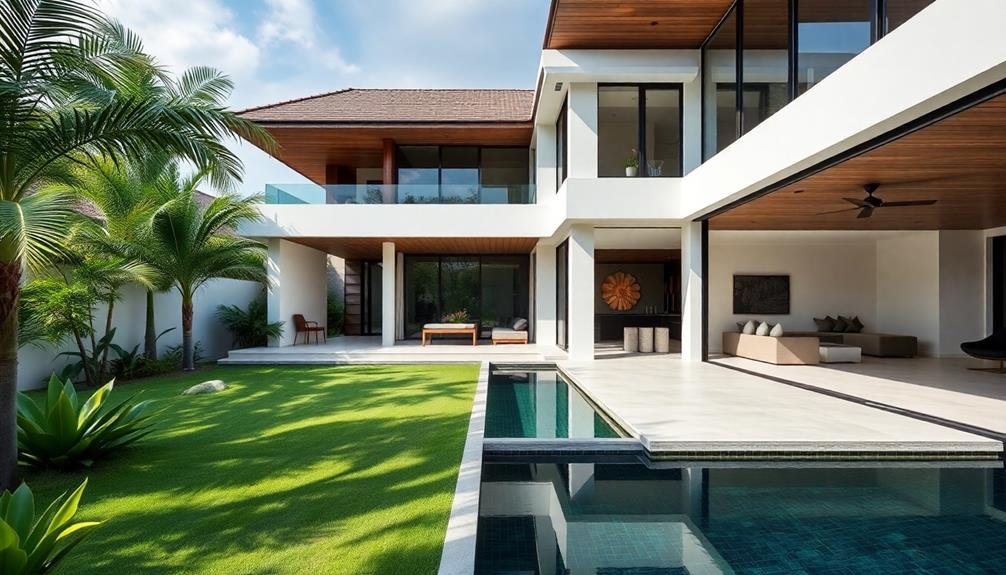When exploring Balinese versus modern home design, you'll discover two enchanting worlds. Balinese architecture emphasizes harmony with nature, using local materials and open spaces to enhance serenity. In contrast, modern designs blend sleek aesthetics and luxurious amenities while incorporating traditional motifs. Both styles celebrate indoor-outdoor living, but Balinese designs highlight spiritual connections and sustainable practices. You can create a home that balances these influences, merging the tranquil essence of Bali with contemporary flair. If you're curious, you might want to explore how each approach can enhance your living space and reflect your personal style.
Key Takeaways
- Traditional Balinese architecture emphasizes cosmic balance and harmony with nature, while modern designs focus on luxury and contemporary aesthetics.
- Local materials like wood, stone, and thatch are integral to traditional designs, promoting sustainability and cultural authenticity in contrast to modern materials.
- Open floor plans in both styles enhance natural light and airflow, but modern designs often prioritize seamless indoor-outdoor living with high-end amenities.
- Spiritual influences in traditional architecture reflect cultural values, while modern designs may prioritize commercial interests, impacting authenticity and community-centric planning.
- Future trends in Balinese architecture aim to integrate sustainability practices while respecting traditional aesthetics and cultural heritage in modern developments.
Traditional Balinese Architecture Overview

Traditional Balinese architecture embodies a profound connection between spirituality and the environment, creating spaces that resonate with harmony and balance. This unique architectural style reflects a rich blend of Hindu-Buddhist and animist influences, evident in intricate carvings and ornamental motifs.
You'll notice that buildings are constructed using local natural materials like wood, stone, and thatch, promoting sustainability while embracing the surrounding landscape. The design also emphasizes open floor plans, enhancing airflow and light, which aligns with the principles of indoor-outdoor living that are integral to Balinese aesthetics.
The design emphasizes cosmic balance through principles like Tri Mandala and Sanga Mandala, integrating spiritual values into everyday life. Traditional structures, from simple huts to elaborate palaces, often feature communal spaces centered around family shrines and temples, serving as multifunctional areas for gathering and worship.
As you explore these architectural wonders, you'll be struck by the vibrant colors that adorn the buildings, harmonizing beautifully with the lush environment. This color palette not only enhances the aesthetics but also provides insights into the cultural heritage of the region.
Traditional Balinese architecture is more than just a visual experience; it's an embodiment of the island's spirit, inviting you to connect deeply with both its people and their beliefs.
Modern Balinese Design Elements
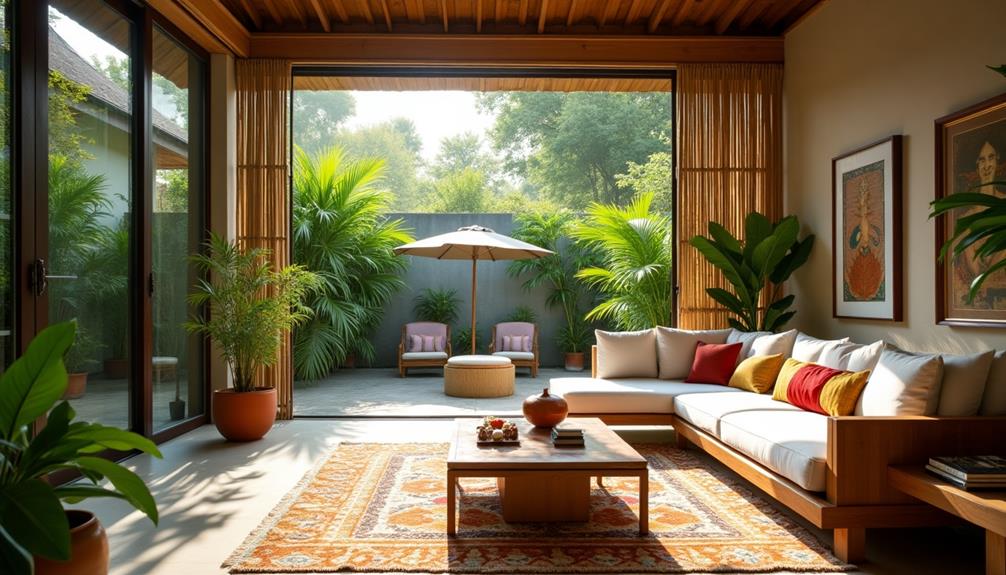
Modern Balinese design elements showcase an enchanting fusion of contemporary aesthetics and traditional motifs, resulting in architectural spaces that feel both luxurious and grounded in nature. This unique style emphasizes spacious villas characterized by sleek lines, seamlessly blending modern design with traditional Balinese charm.
Luxury tropical design aesthetics are evident in the careful selection of materials and the incorporation of local craftsmanship.
Incorporating natural materials like locally sourced stone and hardwood, modern Balinese architecture not only highlights sustainability but also strengthens the connection to the surrounding environment.
You'll often find open-concept living spaces in these designs, promoting a seamless flow between indoor and outdoor areas. This approach enhances your overall living experience, allowing nature to become an integral part of your home.
Modern kitchens and living spaces are equipped with high-end appliances and technology, balancing luxury with sustainability while reflecting Balinese cultural elements through handcrafted furnishings.
Vibrant color palettes inspired by traditional Balinese culture enhance visual appeal and create harmony with the natural surroundings.
Iconic Architectural Sites in Bali
Bali's architectural landscape is rich with iconic sites that reflect the island's cultural and spiritual heritage. One of the most famous is the Tanah Lot Temple, a breathtaking sea temple renowned for its stunning coastal views and intricate traditional architecture. This site draws thousands of visitors each year, enthusiastic to witness its beauty and significance.
The designs of these temples often incorporate elements of modern tropical aesthetics, highlighting the seamless blend of nature and structure that characterizes Balinese architecture.
Another essential site is Besakih Temple, known as the "Mother Temple." This expansive complex features over 80 individual temples and serves as a major pilgrimage destination for Balinese Hindus, deeply rooted in Balinese culture.
Then there's Uluwatu Temple, dramatically perched on a cliff 70 meters above the Indian Ocean. Its cliffside location offers spectacular views and hosts mesmerizing Kecak dance performances at sunset.
Don't miss Goa Gajah, or the Elephant Cave, an archaeological gem dating back to the 11th century. With its intricate carvings and sacred bathing pool, it showcases Bali's rich spiritual heritage.
Each of these iconic architectural sites embodies the Balinese philosophy of harmony with nature, inviting you to explore and appreciate the island's unique blend of culture and history.
Blending Balinese Aesthetics at Home
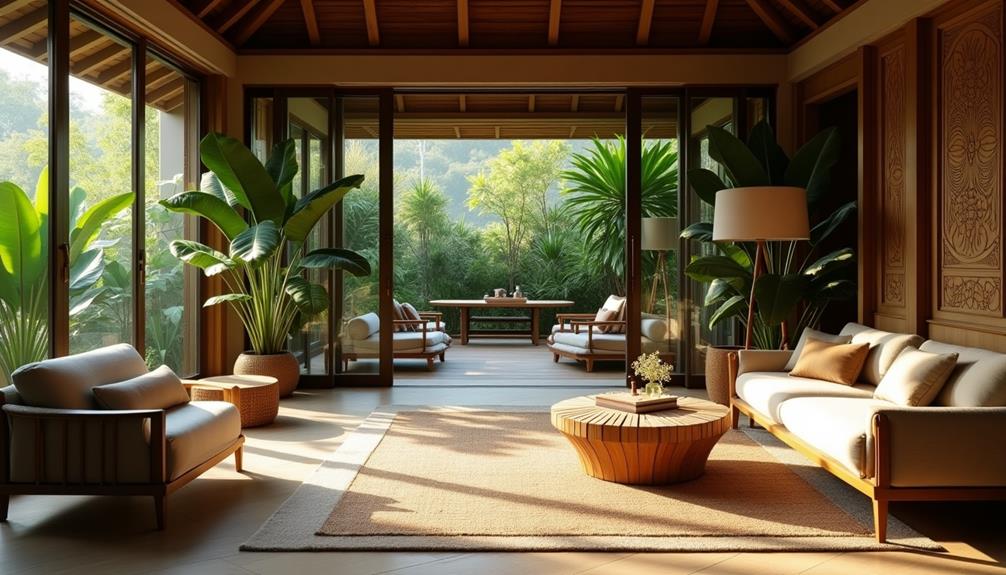
Embracing the beauty of Balinese aesthetics can transform your home into a serene sanctuary that reflects both culture and nature. By incorporating natural materials like wood, stone, and thatch, you not only enhance your home's architectural appearance but also promote sustainability.
These elements are central to both traditional and modern Balinese designs, fostering a harmonious relationship with the environment. Additionally, integrating Indonesian decor masks can further enrich your space, showcasing vibrant artistry that tells stories of local traditions.
Opt for Balinese furniture adorned with intricate carvings and vibrant colors to infuse exotic charm into your living space. This artistic approach captures the cheerful essence of Balinese culture, making your home feel warm and inviting.
Implementing an open-concept design encourages seamless shifts between indoor and outdoor spaces, allowing natural light to flow freely and creating a strong connection with nature. This design choice enhances the overall ambiance, making your home feel more expansive and tranquil.
Additionally, integrating artistic elements such as handcrafted tiles and sculptures can elevate your décor while narrating a story that intertwines tradition with modern living. By blending these features, you create a space that not only looks beautiful but also embodies the spirit of Balinese aesthetics.
Color Schemes in Balinese Design
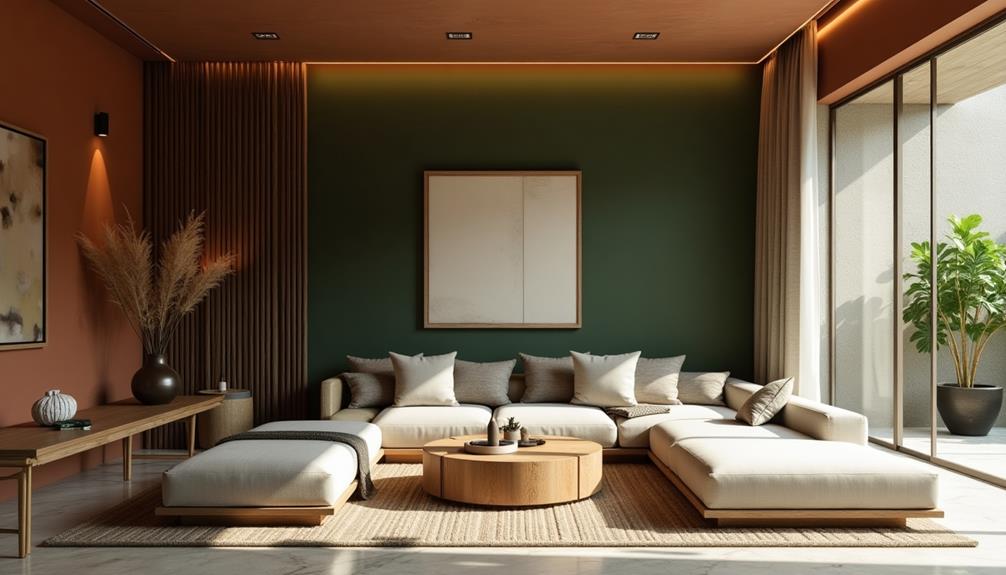
In Balinese design, you'll find vibrant colors that reflect the island's rich culture and joyful spirit.
By incorporating nature-inspired hues, these schemes create a harmonious connection with the environment, enhancing the overall aesthetic of your space.
Whether you lean towards traditional or modern styles, you'll appreciate how these colors can transform your home into a serene sanctuary.
Vibrant Cultural Expressions
Vibrant color schemes breathe life into Balinese design, reflecting the island's cheerful culture. You'll find a vibrant color palette in Balinese architecture that features bold reds, yellows, and greens. These colors not only enhance aesthetic appeal but also provide insight into the cultural heritage and spiritual beliefs of the Balinese people.
Each color choice is strategically selected to create harmony and balance with the environment, emphasizing the connection between human-made structures and nature. Additionally, elements such as Indonesian decorative pillows can complement these vibrant colors, offering comfort while celebrating cultural heritage.
Traditional Balinese buildings showcase intricate carvings and motifs painted in vivid colors, celebrating local artistry and craftsmanship. These elements serve both decorative and symbolic purposes, allowing you to appreciate the rich storytelling embedded in the designs.
As you explore these spaces, you'll experience immersive cultural experiences that transport you into the heart of Bali's artistic expression.
The integration of color in Balinese architecture is essential, making every visit a unique journey through the island's vibrant history. If you're looking to create a similar atmosphere in your home, consider incorporating these vibrant color schemes to reflect the joyous spirit and deep-rooted cultural significance of Balinese design.
Nature-Inspired Color Harmony
Balinese design beautifully harmonizes with nature through its color schemes, reflecting the island's lush landscapes and diverse ecosystems. This approach employs a vibrant color palette that mirrors the cheerful essence of Balinese culture, where bold hues create a stunning color harmony with the surrounding environment.
The integration of indoor plants and local crafts can further elevate this design aesthetic, creating a revitalizing ambiance that resonates with traditional Indonesian style. When you incorporate these bright colors into your space, you're not just beautifying it; you're also tapping into the rich cultural heritage and spirituality behind each shade.
Natural materials, like wood and stone, are often paired with these vivid colors in Balinese architecture, resulting in a visually striking and cohesive design that celebrates the outdoors. This combination enhances the aesthetic appeal of your home, providing insight into the environmental context of the region.
Moreover, the use of nature-inspired colors influences the overall mood, fostering a tranquil atmosphere that connects you to the natural world. By choosing colors that reflect the beauty of Balinese design, you create a space that feels serene and inviting, reminding you of the island's enchanting spirit every day.
Embrace these elements, and your home will resonate with the essence of Balinese culture and nature.
Principles of Balinese Architectural Philosophy

When you explore Balinese architectural philosophy, you'll notice the emphasis on cosmic balance and harmony in every design choice.
This approach often incorporates tropical villa plans that focus on open spaces and natural light, enhancing the serene atmosphere that Balinese homes are known for.
The use of local materials not only enhances sustainability but also connects the structures to their environment.
Furthermore, spiritual influences are woven throughout, reflecting the deep cultural significance behind each element.
Cosmic Balance Integration
Often, the principles of Cosmic Balance in architecture reveal a profound connection between human life and the natural world. This philosophy emphasizes the harmonious integration of our existence with the environment, reflecting deep respect for spiritual values and ecological sustainability.
You'll find that the concept of Tri Mandala plays a significant role in structuring spaces, dividing them into sacred, social, and profane domains, which guides how buildings are laid out. Additionally, incorporating elements like Indonesian decor masks can enhance the cultural storytelling aspect of your space, further enriching its aesthetic appeal.
In Balinese design, spatial orientation is key. Structures are thoughtfully aligned with cosmic elements, like Mount Agung and the sun, reinforcing a sense of interconnectedness with nature.
The use of local materials—wood, stone, and thatch—not only supports sustainability but also echoes the cosmic balance by maintaining the ecological integrity of the area.
Architectural proportions, particularly Tri Angga, guarantee a harmonious relationship between the human scale and the spiritual dimensions of the environment.
Local Materials Utilization
Utilizing local materials is a cornerstone of Balinese architectural philosophy, reinforcing the connection between structures and their natural surroundings. Traditional Balinese architecture emphasizes the use of locally sourced materials like bamboo, thatch, and stone, promoting sustainability and harmony with the natural environment.
This approach can be reflected in various cultural elements, such as incorporating intricate wooden carvings for Indonesian wedding decor, which adds a unique touch to the design while celebrating cultural craftsmanship. By choosing these materials, you not only support the local economy but also enhance the cultural authenticity of your home.
Incorporating local materials into your architectural design reflects the craftsmanship that's deeply rooted in Balinese culture. This practice guarantees that your home resonates with the area's unique aesthetics while respecting resource availability.
Balinese architecture prioritizes the environmental appropriateness and durability of materials, aligning with sustainable living principles.
Modern Balinese architecture continues this tradition, blending local materials with contemporary design elements. This fusion creates a striking balance between tradition and innovation, allowing your home to embody both cultural significance and modern comfort.
As you explore home design, remember that utilizing local materials isn't just about aesthetics; it's also about honoring the spiritual principles that guide this timeless architectural philosophy. Embracing these elements will help you create a space that feels authentically connected to its environment.
Spiritual Influences Reflection
As you explore Balinese architectural philosophy, you'll discover that spiritual influences play a pivotal role in shaping the design and layout of spaces. This philosophy emphasizes a deep connection between humans, nature, and the divine, reflecting a balance in the cosmos through various principles.
Traditional Indonesian housing, often constructed with local materials, exemplifies this relationship. Here are key aspects that embody this spiritual meaning:
- Tri Hita Karana: This principle fosters harmony between humans, nature, and the divine, guiding the overall design approach.
- Tri Mandala: It divides spaces into three domains—inner, middle, and outer—ensuring that structures align with spiritual significance and community functions.
- Asta Kosala Kosali: Serving as a framework for shapes and ratios, this principle promotes designs that incorporate local traditions and environmental considerations.
- Sanga Mandala: Organizing space into nine parts, it emphasizes cultural values and protection through Hindu guardians.
For more on how these principles influence housing structures, check out traditional Indonesian housing styles like Rumah Adat.
Impact of Tourism on Design
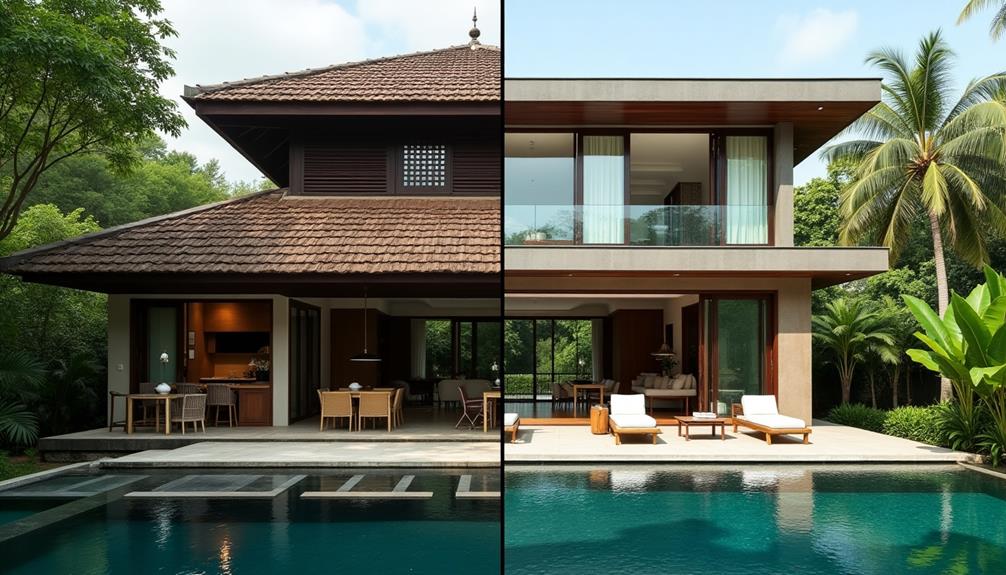
Transforming landscapes, the surge in tourism has dramatically influenced architectural design in Bali. You'll notice how the impact on spatial planning has led to significant changes in Balinese architecture. Once focused on cosmic orientation and traditional values, many new structures now reflect modern commercial influences. This shift often results in structural and functional changes that prioritize luxury over authenticity in its original form.
Local regulations in architecture have also adapted, frequently prioritizing commercial interests at the expense of preserving the cultural significance of Balinese designs. As you explore, you might see a blend of modern amenities that, while appealing, risks losing the essence of traditional architecture.
To help you understand these dynamics, here's a table outlining the contrasts:
| Traditional Architecture | Modern Architecture |
|---|---|
| Cosmic-oriented design | Commercial influences |
| Emphasis on traditional value | Focus on luxury and amenities |
| Authenticity in its original | Structural functional changes |
| Local craftsmanship | Global design trends |
| Community-centric planning | Profit-driven development |
As tourism continues to grow, merging these modern designs with traditional Balinese principles is vital to sustaining cultural integrity.
Future Trends in Balinese Architecture
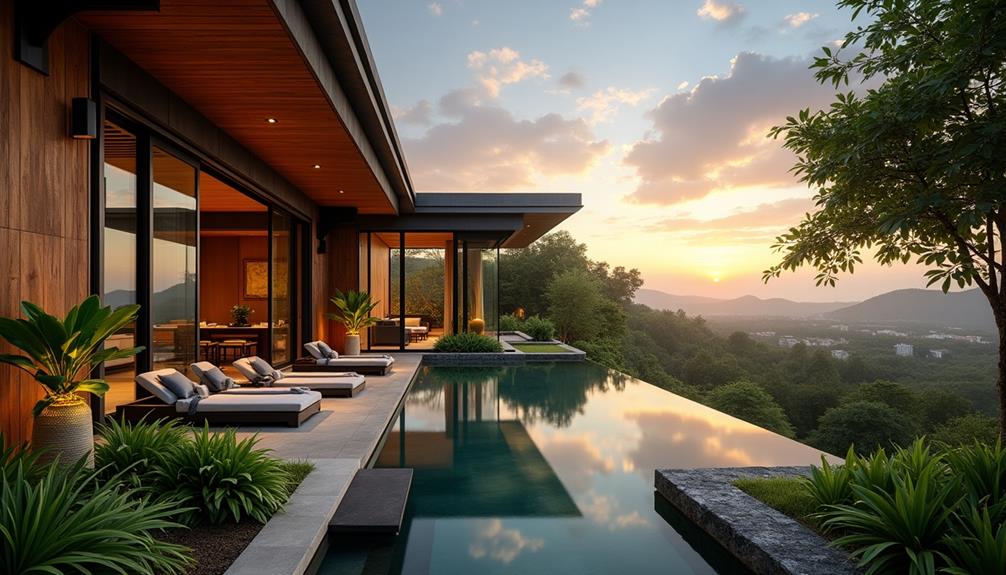
Balinese architecture is on the brink of a remarkable evolution, where traditional principles seamlessly merge with modern sustainability practices. This shift aims to honor the cultural heritage and spiritual values of the island while embracing eco-friendly innovations.
As you explore future trends, consider these key aspects:
- Integration of Modern Sustainability Practices: New designs will prioritize energy efficiency and minimal environmental impact, ensuring that buildings harmonize with nature.
- Role of Undagi: Traditional architects will play a significant role in this architectural evolution, guiding projects that respect Balinese values.
- Open-Concept Spaces: Expect to see designs that blur the lines between indoors and outdoors, maximizing Bali's stunning landscapes and climate.
- Use of Eco-Friendly Materials: Future constructions will favor sustainable materials that reflect the aesthetics of traditional Balinese architecture while promoting durability.
Frequently Asked Questions
What Is the Balinese Design Philosophy?
The Balinese design philosophy emphasizes harmony between human life and nature. You'll find it values cosmic balance, integrates local materials, and reflects spiritual beliefs, creating spaces that resonate with their surroundings and cultural heritage.
What Are the 7 Philosophies of Balinese Architecture?
You'll be amazed by the seven Balinese architecture philosophies! They intertwine spiritual harmony, zoning, sacred space, proportionality, traditional shapes, and communal beliefs, creating a breathtaking balance that'll leave you in awe of their design wisdom!
What Are the Principles of Balinese Architecture?
The principles of Balinese architecture emphasize harmony among humans, nature, and the divine. You'll notice spatial organization, sustainable materials, and aesthetic balance, all reflecting the culture's spiritual beliefs and environmental respect in every design.
What Is the Balinese Design Element?
Imagine vibrant colors dancing in the sunlight, natural materials embracing the earth. Balinese design elements blend indoor and outdoor spaces, intricate carvings tell stories, and harmony with nature invites you into a serene, enchanting world.
Conclusion
As you step into a home that marries Balinese charm with modern flair, you're enveloped in warmth and serenity. Picture lush greenery framing sleek lines, where sunlight dances across handcrafted wooden beams. This blend creates a sanctuary that whispers tales of tradition while embracing contemporary life. The future of Balinese architecture isn't just about aesthetics; it's a harmonious dialogue between the past and present, inviting you to experience beauty, comfort, and a sense of belonging in every corner.
